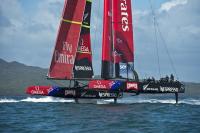 After looking like they were in an impossibly deep hole, Oracle Team USA has come charging back. Only last Wednesday, Emirates Team New Zealand was on the verge of winning the America’s Cup. They had won 8 of the 9 races necessary for victory while Oracle had only won 3. But, as Oracle had been penalized 2 races for cheating during the prior round of races, the tally board stood at 8-1. Now, Oracle has won the last five races. In absolute terms Oracle and the Kiwis have both won 8 races and the momentum is clearly on Oracle’s side. All it will take is the Kiwis winning a single race to take the Cup. Based on the last five races, the next one, two or three races, as necessary, will be hard fought indeed.
After looking like they were in an impossibly deep hole, Oracle Team USA has come charging back. Only last Wednesday, Emirates Team New Zealand was on the verge of winning the America’s Cup. They had won 8 of the 9 races necessary for victory while Oracle had only won 3. But, as Oracle had been penalized 2 races for cheating during the prior round of races, the tally board stood at 8-1. Now, Oracle has won the last five races. In absolute terms Oracle and the Kiwis have both won 8 races and the momentum is clearly on Oracle’s side. All it will take is the Kiwis winning a single race to take the Cup. Based on the last five races, the next one, two or three races, as necessary, will be hard fought indeed.
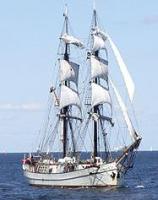 On July 24th, the Dutch sail-training brig Astrid sank after running aground on rocks on the Irish coast on the western mouth of Oysterhaven, near Cork. On September 13th, the ship was lifted off the rocks using a 937-tonne floating crane and placed on deck barge. She was then towed to the port of Kinsale. There had been hope that the ship could be salvaged, but after surveyors inspected the damage to the 95-year-old 136′ (41.65 M) brig, they determined that the cost of repairs would exceed the value of the ship. The ship will be taken to Cork to be scrapped. Thanks to Erik Abranson for contributing to the post.
On July 24th, the Dutch sail-training brig Astrid sank after running aground on rocks on the Irish coast on the western mouth of Oysterhaven, near Cork. On September 13th, the ship was lifted off the rocks using a 937-tonne floating crane and placed on deck barge. She was then towed to the port of Kinsale. There had been hope that the ship could be salvaged, but after surveyors inspected the damage to the 95-year-old 136′ (41.65 M) brig, they determined that the cost of repairs would exceed the value of the ship. The ship will be taken to Cork to be scrapped. Thanks to Erik Abranson for contributing to the post.
Scientists have found the record of a whale’s life in, of all places, its ear. The carcass of a blue whale, which died after being struck by a ship, has yielded a 10″ slab of ear wax which researchers have found to reveal not only the age of the whale, but also its stress level, and the pollutants in the water in which the whale was swimming.
This Dead Whale Is Helping Science in an Incredibly Gross Way
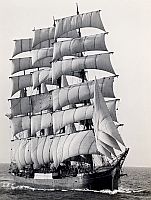 When did the great age of sail finally end? (Some would argue that it is not yet over.) If one was to pick a single date when it finally came to a close, I would choose today, fifty six years ago, September 21, 1957, when the last cargo carrying windjammer, Pamir, sank off the Azores in Hurricane Carrie. Her cargo of grain, which had not been properly stowed, shifted in the storm and the ship capsized. Of her crew of 86, including 52 cadets, only 6 survived.
When did the great age of sail finally end? (Some would argue that it is not yet over.) If one was to pick a single date when it finally came to a close, I would choose today, fifty six years ago, September 21, 1957, when the last cargo carrying windjammer, Pamir, sank off the Azores in Hurricane Carrie. Her cargo of grain, which had not been properly stowed, shifted in the storm and the ship capsized. Of her crew of 86, including 52 cadets, only 6 survived.
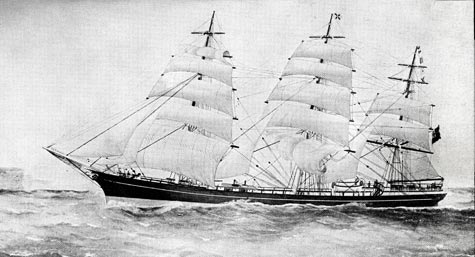
Windjammer British Isles
On Wednesday I raised the question – is history just a sea story? I found in researching my novel, Hell Around the Horn, that two memoirs written about the voyage of the British windjammer, British Isles, on which the novel is based, do not agree with each other or the Official Ship’s log. There was, however, one event on which all three primary sources agreed. The British Isles was struck and nearly sunk by an unusually large and massive wave. Ironically, this part of the story was not believed, even by experienced sailors of the time. See our previous post, Rogue Wave, 1905, and the Squarerigger British Isles
Alan Villiers who was an experienced Cape Horn sailor, didn’t believe that a single wave could do so much damage, dismissing it out of hand. In his book, War with Cape Horn, he comments on the damage to the ship: It is strange that the ship was so much damaged from her brush with the Horn. She was in the area for ten weeks, which is at least seven longer than was enough, but she was strongly built to take that sort of punishment indefinitely.
Until recently, such large waves were thought simply not to exist. Their reports had to be exaggerations or even excuses. When a ship was damaged in heavy weather by a freak wave, many thought that the captain was trying to cover for his inattention or attempt to carry sail for too long. The reports of huge waves were treated liked fish stories where the size of a fish caught on a fishing trip increased with the telling.
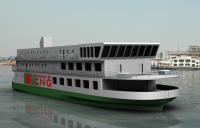
Winning design from University of British Columbia
In June, we posted about the Safe Affordable Ferry Design Competition, sponsored by the World Ferry Safety Association, in which student teams from six maritime universities competed to develop a ferry design for a 500 passenger ferry for Bangladesh. Recently the competition winners were announced. The awards will be presented at the Annual Meeting of Interferry, in Malta, on October 7.
A top prize of $5000 is to been awarded to the student team from the University of British Columbia, Canada. The team designed a monohull vessel that had exceptional stability characteristics. The entry was very complete in terms of design features and cost and fuel analysis. Features include CNG fueled engines, modular cabins, and handicapped access.
 I would like to thank all the readers and supporters of the Old Salt Blog. Today is the fifth anniversary of the very first post, five years ago. So happy birthday to us all. Since September 19th, 2008, the blog has been visited by 968,229 unique visitors, who have viewed 1,640,344 blog pages. Not too shabby for a personal blog. Thanks to everyone for stopping by. Please have a slice of virtual birthday cake.
I would like to thank all the readers and supporters of the Old Salt Blog. Today is the fifth anniversary of the very first post, five years ago. So happy birthday to us all. Since September 19th, 2008, the blog has been visited by 968,229 unique visitors, who have viewed 1,640,344 blog pages. Not too shabby for a personal blog. Thanks to everyone for stopping by. Please have a slice of virtual birthday cake.
This is also happens to be, regrettably, International Talk Like A Pirate Day, in which many pay homage to the Disney view of piracy, while ignoring both current events and history. Not coincidentally, five years ago today, our very first blog post was “Thank You for Not Talking Like A Pirate,” which we are reposting below:
Thank You for Not Talking Like A Pirate
If by good fortune you missed the “International Talk Like a Pirate Day”, just as well. If you managed to pass the day without a single “Aargh” or “Shiver Me Timbers” congratulations.
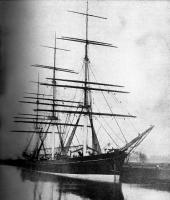
Ship British Isles
What is history? What is fiction? These seem to be straightforward questions. The conventional answer would be that history is what happened and fiction are the stories that we make up. In writing my recent novel I was faced with these questions and have come away with only more questions. My novel, Hell Around the Horn, is based on an actual voyage of the British windjammer, British Isles, from Cardiff, Wales to Pisaqua, Chile in the the terrible Cape Horn winter of 1905. Unlike most windjammer voyages of the late 19th and early 20th centuries, the 1905 voyage of the British Isles was very well documented. And that is where the troubles start.
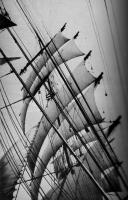
Windjammer British Isles, inspiration for the Lady Rebecca
My novel Hell around the Horn is set on a British windjammer on a voyage around Cape Horn in the particularly brutal winter of 1905. I wanted to write the novel, in part, because the windjammers have been largely forgotten in these days when any vessel that sets square sails is too often simply called a “pirate ship.” The windjammers were perhaps the greatest sailing vessels ever to cross the oceans. These ships and those who sailed them, deserve better.
William Faulkner once wrote, “the past isn’t dead it isn’t even past.” The same can be said of windjammers. While too often forgotten, they are not yet dead, and they certainly are not past.
But what was a “windjammer?”
This was the most perilous phase of the salvage of the wrecked cruise ship, Costa Concordia. The parbuckle rolling of the ship upright was where everything could go wrong. The biggest concern was that the stress would break the already damaged ship apart. Nevertheless, despite going somewhat slower than originally planned, the operation was a success. The ship is upright again. It will take several months before the ship is ready to be towed away to the scrap yard. Below, a time-lapse video of the salvage, the 19 hour process reduced to about a minute.
From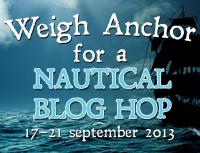 Tuesday, September 17 through Saturday, September 21st, we will participating in “Weigh Anchor,” a nautical blog hop organized by the wonderful Helen Hollick. She has brought together twenty three writers of nautical fiction and non-fiction to post about their work and other interesting topics with nautical themes. If you were unaware that there were 23 authors writing about ships and the sea, here is a great opportunity to meet them.
Tuesday, September 17 through Saturday, September 21st, we will participating in “Weigh Anchor,” a nautical blog hop organized by the wonderful Helen Hollick. She has brought together twenty three writers of nautical fiction and non-fiction to post about their work and other interesting topics with nautical themes. If you were unaware that there were 23 authors writing about ships and the sea, here is a great opportunity to meet them.
As my novel “Hell Around the Horn” is set on a windjammer, one of the last mighty sailing ships to carry one toward the end of the great age of sail, I will be posting a “Week of Windjammers.” (Technically, it may be only five days but I like the alliteration. And who knows I may add on a few days to make it a full week.)
Updated: 15:30 – The number of dead has risen to at least twelve. One shooter is dead and one may be still at large.
Updated 13:02 – The Washington Post is reporting that as many as three gunmen opened fire this morning at the Naval Sea Systems Command in the Washington Navy Yard killing at least nine. From the Washington Post: “At least nine people are dead after as many as three shooters dressed in military style uniforms opened fire a rampage at the Washington Navy Yard on Monday, police said, spreading fear and chaos across the region as authorities tried to contain the incident. D.C. Police Chief Cathy Lanier said in a mid-day news conference that one of the suspected shooters is dead, while authorities are looking for two other possible suspects wearing military style clothing.” The Navy Yard is about 1.5 miles from the U.S. Capitol and 4.5 miles from the Pentagon. The Washington Navy Yard is the oldest shore establishment of the U.S. Navy, established in 1799.
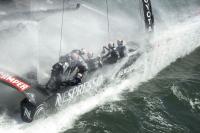 At first it looked like the 34th America’s Cup races would be a route. Emirates Team New Zealand was simply out-sailing the defender, Oracle Team USA. Not only was the crew making fewer mistakes but the Kiwi’s boat seemed noticeably faster to windward. In the first five races, the Kiwis won four, compelling Oracle to call a time-out before race six, using its one race postponement card to give the team time to reassess. Races 6 & 7 were also Kiwi wins but things changed dramatically in Race 8. The Kiwis almost capsized, losing the race and coming perilously close to ending their hope of winning the Cup. The Oracle boat also seemed much quicker to windward. Races 9 & 10 confirmed the transformation. Once the laggard, Oracle now appears to have a windward speed advantage, either due to changes in the boat, new crew tactics or both. They won Race 9 and only lost 10 in an exciting squeaker, falling 47 seconds behind the Kiwis.
At first it looked like the 34th America’s Cup races would be a route. Emirates Team New Zealand was simply out-sailing the defender, Oracle Team USA. Not only was the crew making fewer mistakes but the Kiwi’s boat seemed noticeably faster to windward. In the first five races, the Kiwis won four, compelling Oracle to call a time-out before race six, using its one race postponement card to give the team time to reassess. Races 6 & 7 were also Kiwi wins but things changed dramatically in Race 8. The Kiwis almost capsized, losing the race and coming perilously close to ending their hope of winning the Cup. The Oracle boat also seemed much quicker to windward. Races 9 & 10 confirmed the transformation. Once the laggard, Oracle now appears to have a windward speed advantage, either due to changes in the boat, new crew tactics or both. They won Race 9 and only lost 10 in an exciting squeaker, falling 47 seconds behind the Kiwis.
Is this Oracle resurgence too late? The Kiwis only have to win two more races to claim the Cup while Oracle has to win another seven to hold it. If the last two races are any indication, the final races in 34th America’s Cup will be extremely exciting. If Oracle manages to dominate the last races and win, it will be a comeback tale for the ages.
The parbuckling of the cruise ship Costa Concordia is proceeding as intended after a three hour delay due to a thunderstorm. If all goes well, the process should take 10 hours to roll the ship upright from its current position, rolled 65 degrees over on its side off the island of Giglio. If successful, the operation will be the largest intact ship salvage in history. For a live video feed of the operation, click here.
In brisk winds on Saturday, Emirates Team New Zealand’s hopes of winning the America’s Cup nearly came to an end when they came perilously close to capsizing during a tack in Race 8 of the Americas’ Cup races in San Francisco. The Kiwi wingsail did not release in time during the tack and the boat rolled high on one hull before slowly righting itself. Two AC72s have capsized in practice sails. In both cases, each boat was significantly damaged, and in one case a man was killed.
Race 9 was cancelled due to winds being too strong. Oracle Team USA came back with a win after two losses to the Kiwis and showed improved windward performance overall. Notwithstanding the considerable point lead by the Kiwis, Oracle is clearly not out of the competition.
 Tomorrow, if all goes well, a small army of engineers, technicians and mariners will attempt to roll the stricken cruise ship, Costa Concordia, upright from where she sank on the island of Giglio on January 13, 2012. Once upright the ship will be refloated and towed to a scrap yard. If successful, it will be the largest intact salvage of any ship in history.
Tomorrow, if all goes well, a small army of engineers, technicians and mariners will attempt to roll the stricken cruise ship, Costa Concordia, upright from where she sank on the island of Giglio on January 13, 2012. Once upright the ship will be refloated and towed to a scrap yard. If successful, it will be the largest intact salvage of any ship in history.
The process is called “parbuckling.” Parbuckling is commonly defined as the use of “a kind of purchase for hoisting or lowering a cylindrical burden, as a cask. The middle of a long rope is made fast aloft, and both parts are looped around the object, which rests in the loops, and rolls in them as the ends are hauled up or payed out.” The salvage companies involved in the project have set up a website to explain what will be done – The Parbuckling Project. In this case the Costa Concordia is a very large cask, indeed. See also Parbuckle salvage. Parbuckling has been used successfully to right the battleship USS Oklahoma (BB-37) which was sunk at Pearl Harbor in 1941 and the passenger/ro-ro ferry Herald of Free Enterprise which capsized in 1987. Both ships were significantly smaller than the Costa Concordia.
Fortunately, the ship itself is not quite as heavy as is being reported in the media. There have been repeated references to the Costa Concordia as a “100,000 ton” ship or as a ship that weighs over 100,000 tonnes. Slate is pretty typical in asking, “How Do You Move a 100,000-Ton Capsized Cruise Ship?” (The obvious answer is – very carefully.)
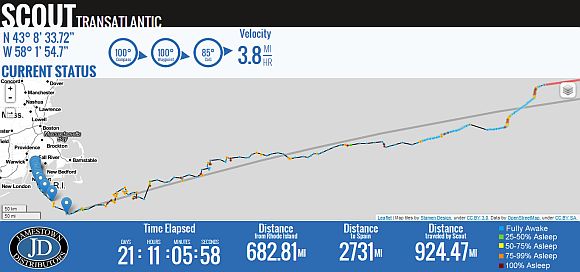 Scout is on its way to Spain! It is a twelve foot long autonomous robotic boat designed to cross the Atlantic Ocean, relying only on pre-programmed commands and information that it can collect about its environment through sensors. Built by a group of engineering students it looks like a bit like a surfboard with a sailboat keel covered with solar cells. It departed 21 days ago from Rhode Island and is now almost 700 miles closer to its destination. Other autonomous robotic boat projects, such as Robotboat Mark VI, rely on sail propulsion. The designers chose solar power driving a propeller as the simplest solution. To follow Scout on its slow but steady voyage across the Atlantic, click here.
Scout is on its way to Spain! It is a twelve foot long autonomous robotic boat designed to cross the Atlantic Ocean, relying only on pre-programmed commands and information that it can collect about its environment through sensors. Built by a group of engineering students it looks like a bit like a surfboard with a sailboat keel covered with solar cells. It departed 21 days ago from Rhode Island and is now almost 700 miles closer to its destination. Other autonomous robotic boat projects, such as Robotboat Mark VI, rely on sail propulsion. The designers chose solar power driving a propeller as the simplest solution. To follow Scout on its slow but steady voyage across the Atlantic, click here.

The Emirates Team New Zealand challengers continue their winning streak against the defending Oracle Team USA, winning races 6 and 7. The Kiwis need only three more races to win the best of nine series to win the America’s Cup. To keep the Cup, Oracle needs to win another ten races. The Kiwis continue to appear to have a noticeable upwind speed advantage while Oracle may have a downwind edge.
At the end of July, we posted about the sinking of the Dutch sail training ship, Astrid, a 136′ (41.65 M) brig, which ran aground on rocks on the western mouth of Oysterhaven, on the Irish coast, near Cork. She was recently salvaged by West Cork-based Atlantic Towage and Marine with a 937-tonne floating crane, the Atlas, which lifted the steel brig off the rocks. The Astrid was moved safely to the port of Kinsale where she was placed on a deck barge. A video of the salvage:
